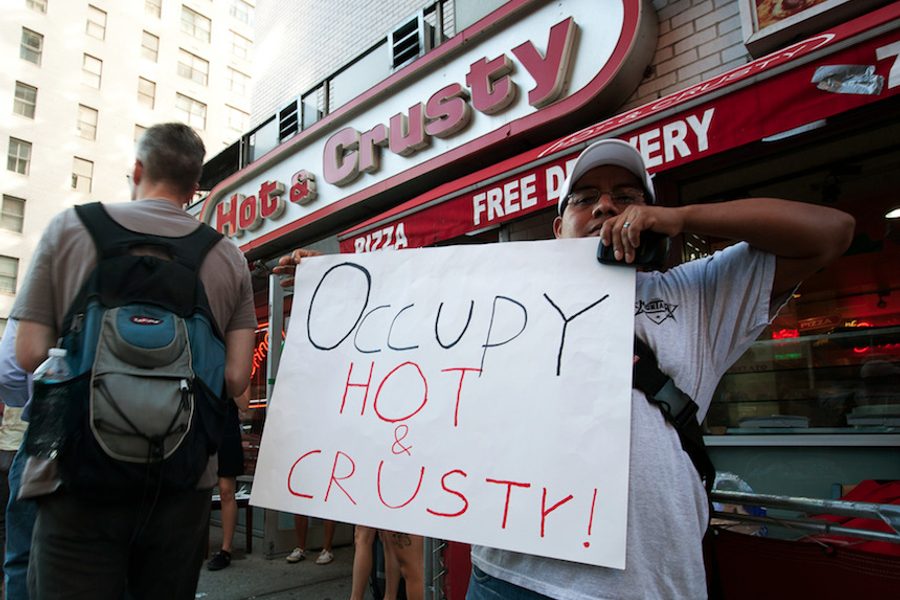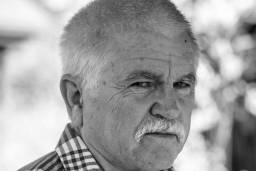
Midway through The Hand That Feeds—a new documentary by Rachel Lears and Robin Blotnick — Mahoma López, a shy Mexican immigrant restaurant worker, reflects on the effectiveness of a labor organizing tactic used by workers at Hot and Crusty, a New York City café and bakery. They put the faces and names of abusive managers and restaurant owners on fliers, and distribute them to passersby on the sidewalks of Manhattan’s Upper East Side.
As grainy cell phone footage of managers angrily pushing union organizers and workers in the street and kicking the fliers flashes across the screen, Lopez flatly states, “It works really well. It really puts them in their place.”
At the Chicago theater where I recently watched the documentary, the crowd of around two hundred fast-food workers and members of the Fight for 15 campaign erupted in laughter at Lopez’s deadpan commentary — not only because it felt hilariously incongruent with the scenes of workers and managers nearly coming to blows, but also because the Hot and Crusty unionization struggle closely mirrors the battle for decent pay of these Chicago workers and so many other low-wage workers around the country.
That resonance with some of the key labor struggles in the US is what sets The Hand That Feeds apart from other deeply moving, masterfully crafted documentaries. The film is an affecting portrait of how average workers — apolitical, shy, suspicious of collective action, fearful of their bosses, and unaware of their own power — become militants who march in the streets, confront their bosses, and partner with young activists who occupy their workplace.
At a time when the American labor movement is at its weakest in a century, with unions witnessing their ranks reduced in waves, and experiments in non-union labor organizing increasingly relevant, the film offers a compelling reminder that workers can fight back and win.
Mahoma López and his coworkers are nearly all undocumented Latino immigrants, and the neighborhood they work in exemplifies the vast inequalities of New York City and America today: throughout the film, wealthy New Yorkers, complete with designer sunglasses and tiny dogs, parade across the screen as Hot and Crusty workers staff the counter.
Many are paid below minimum wage, receive no overtime pay, and are constantly mistreated by management. The opening scene shows Margarito López (no relation to Mahoma), a gray-haired dishwasher, counting his take-home pay after a sixty-hour workweek: $290.
Restaurant workers across the country could tell similar stories — one recent poll reported that 84 percent of fast-food workers have experienced wage theft, and the Economic Policy Institute estimates that US workers lose $50 billion annually in stolen pay. Pilfered wages are especially common in low-paying industries.
Most low-wage workers deal with abuse and theft individually, moving from job to job in search of a decent workplace. But the Hot and Crusty workers decided to take on the boss together. One of the workers had a friend who had experienced similar abuse in the past and said he knew a group that could help: the Laundry Workers Center (LWC).
The LWC, founded in 2011, is not just for laundry workers — it’s a workers center that fights to improve the lives of employees and their families in both the laundry and food-service industries in New York and New Jersey. They tackle a range of issues, including hazardous working conditions, negligent landlords, and wage theft.
The center is part of a relatively recent organizing trend spearheaded by “alt-labor” groups — community-based organizations whose organizing and outreach methods differ from standard union strategies. Virgilio Arán, an LWC organizer, says that the group receives no union or foundation money and will organize anyone.
The film tells the story of how the workers, with the help of Arán, Nastaran Mohit (another LWC organizer), and union lawyer Ben Dictor, move from isolation and resignation to fighting for a union — the Hot and Crusty Workers Association.
After months of building an organizing committee and battling the boss’s attempts to prevent their unionization, the workers file for a union election — and win. Workers and organizers are ecstatic, high-fiving each other in the streets and toasting each other at the bar afterwards.
But the apparent victory is the first of many scenes in which the hearts of all but the most fervent Ayn Rand – quoting investment bankers will swell, only to be crushed a few scenes later. Shortly after winning unionization, the owners of Hot and Crusty say they can’t afford to pay union wages and announce they are closing the restaurant.
As at so many workplaces, the workers’ Herculean organizing efforts — persistently attempting to convince their coworkers of the value of collective action, facing serious risks to themselves and their families, and staring down myriad management attempts to destroy the union in its infancy — seem to be all for naught, as management pleads poverty and decides to head somewhere else (where, not coincidentally, they won’t be bothered by uppity union workers).
“What happens,” asks Dictor, “when you have a group of workers who do everything by the book? They win all the way, and then the boss just finds a way to screw them over anyway.”
But the Hot and Crusty workers don’t give up. Knowing the café’s claims are an excuse to bust the union, they begin a campaign to pressure the owners to reopen.
To build support for their campaign, the workers and LWC organizers reach out to participants of another struggle taking place on the other end of Manhattan: Occupy Wall Street.
In 2011, many unions and rank-and-file members joined the Occupy in the streets of New York and in cities around the country, supporting the movement’s message and even getting arrested alongside the occupiers. But LWC was one of the only worker organizations to actively seek occupiers’ concrete support.
The film shows Arán and Mahoma Lopez standing in the Deutsche Bank atrium at 60 Wall Street, a hub for much of the movement, asking for assistance at an Occupy subcommittee meeting. Soon after, a mass OWS march heads to Hot and Crusty, and slightly scruffy young occupiers begin helping the workers hand out fliers.
On the day before the restaurant is set to close, workers and Occupy activists march on Hot and Crusty, and the activists briefly occupy the café before being dragged out in handcuffs by the New York Police Department. As Mohit is led to a squad car, she appears to be doing her best impression of Dade Murphy in Hackers, yelling, “We’ll be back! Twenty-four-hour picket! Twenty-four-hour picket!”
Rather than a depressing monument to bosses’ ultimate power over workers, the employees turn the closed café and the sidewalk in front of it into the site of a vibrant picket line. Workers and supporters create a joyful protest, distributing food and coffee, and engaging passersby in their struggle by encouraging them to leave voicemails for Hot and Crusty investors. A prepubescent passerby in braces demands, “You need to open up Hot and Crusty. I need my lunch. Pay your workers more money, you bum.”
Meanwhile some of the Occupy activists argue with comically conservative business owners. A middle-aged man in a fleece vest and fancy watch lectures the young radicals. “You wanna get rich?” he counsels. “Go to work, don’t take a day off. I’ve never taken a day off.” As an earnest activist continues to plead for his support, he responds, “I am supporting you. I just gave you more knowledge than you got in college.”
After the occupation and campaign, the LWC continues to look for a buyer that will recognize the union, and after a few false starts, one is eventually found. The café reopens, with a union; the workers are victorious.
“What do we occupy next?” Mahoma asks.
The Hand That Feeds does an excellent job capturing the raw human drama that characterizes every organizing attempt in the twenty-first century, when workers are kept under the thumb of American labor law. In addition to providing a rare portrait of a victorious labor campaign, the film documents how campaigns like the Hot and Crusty battle can change workers on a personal level.
Near the end of the film, Mahoma explains that, as a result of his experience, he will refuse to put up with management abuse in the future. “You, as a business owner — if you violate my rights, you’ll face the consequences,” he says. “Because we’ve changed now. Our eyes have been opened.”
The Hot and Crusty campaign also affects individuals outside the workplace. Mahoma’s wife Elizabeth is a Pentecostal Christian who disapproves of some of his organizing efforts, hinting early in the movie that she thinks Occupy Wall Street might be a sign of the End Times. Yet as the film concludes, she is out in the street protesting with one of her and Mahoma’s sons, holding a sign bearing an Old Testament verse decrying wage theft.
“I want them to be just like their dad,” she says of her two children.
The Hand That Feeds also highlights the potential power of alternative labor organizations and strategies, which have come to feel more and more necessary as unions continue to decline.
Leftists and labor activists have long complained about unions’ unwillingness to organize low-wage workers. But unions have never had much financial incentive to organize such workers; in fact, the opposite is true. Union dues are typically a percentage of a worker’s paycheck. Since unions rely on dues money to function, they naturally want the highest amount of dues possible.
So why would a union choose to focus on organizing, say, workers earning minimum wage, since the dues those workers could pay would be so miniscule? Unless the union could sign up massive numbers of low-wage workers at once (as SEIU has done at the state level in home health care campaigns, for example), it wouldn’t make much financial sense for them to do so.
Alt-labor organizations like the LWC don’t have to obey this logic.
Still, groups like LWC have their own limitations. Many (though not LWC) rely on foundation funding, whose dictates can have a conservatizing effect. And workers centers, much like community groups, often have a difficult time matching the scale of union organizing, whether because they have fewer resources or because the workplaces they are organizing are more diffuse.
The Hot and Crusty victory itself was somewhat limited. While the workers moved heaven and earth to win their union, facing down the risk of deportation and overcoming their bosses’ lopsided power advantage to win, their victory ultimately relied on finding a benevolent new owner willing to recognize the union — which was then extended to less than two dozen workers.
Nonetheless, one comes away from The Hand That Feeds with the feeling that collective action really can get the goods — that all of the risks and heartbreak that go into organizing might just be worth it. And at a time of such widespread working-class demobilization, such a message is desperately needed.
In a post-film Q & A with the filmmakers and Adriana Alvarez — a veteran McDonald’s worker and leader in the Chicago Fight for 15 campaign — an audience member asked Alvarez if she thought about occupying her McDonald’s after watching Hot and Crusty workers’ allies do the same.
“We hadn’t thought about occupying it yet,” she stated, the wheels clearly turning in her head. “But it’s a good idea.”
Micah Uetricht is an editor at Jacobin magazine. He is a contributing editor and former associate editor at In These Times, and the author of Strike for America: Chicago Teachers Against Austerity and coauthor of Bigger Than Bernie: How We Go From the Sanders Campaign to Democratic Socialism, and is currently at work on a book on New Leftists who took jobs in industries like steel and auto to organize on the shop floor.








